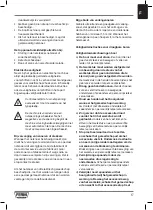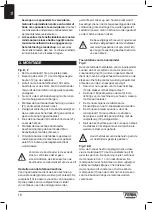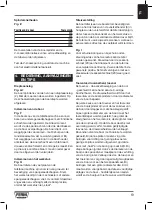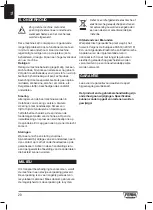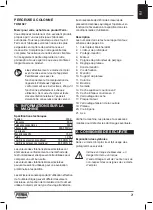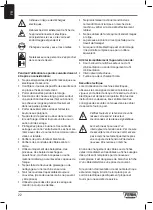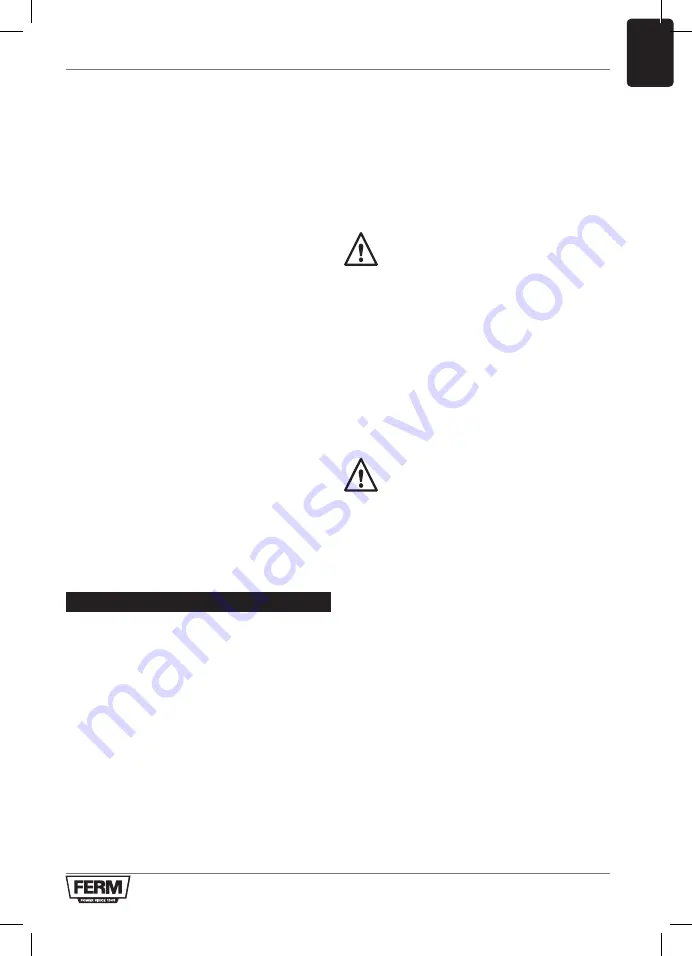
7
EN
d)
Keep your hands out of the drilling area
while the tool is running.
Contact with
rotating parts or chips may result in personal
injury.
e)
Make sure the accessory is rotating before
feeding into the workpiece.
Otherwise
the accessory may become jammed in the
workpiece causing unexpected movement of
the workpiece and personal injury.
f)
When the accessory is jammed, stop
applying downward pressure and switch
off the tool. Investigate and take corrective
actions to eliminate the cause of the jam.
Jamming can cause unexpected movement of
the workpiece and personal injury.
g)
Avoid generating long chips by regularly
interrupting downward pressure.
Sharp
metal chips may cause entanglement and
personal injuries.
h)
Never remove chips from the drilling
area while the tool is running. To remove
chips, move the accessory away from the
workpiece, switch off the tool and wait for
the accessory to stop moving. Use tools
such as a brush or hook to remove chips.
Contact with rotating parts or chips may result
in personal injury.
i)
Accessories with speed ratings must be
rated at least equal to the maximum speed
marked on the power tool.
Accessories
running faster than their rated speed can break
and fly apart.
3. ASSEMBLY
Fig. B, F
• Place the footplate (13) in the correct position.
• Fasten the column (11) with the bolts supplied
(12) to the footplate.
•
Now slide the table holder (10) with the table
over the column (11). With the fastening handle
(6) the table is fastened into the desired position.
• Now you can assemble the machine casing
and lock with the locking pins (8).
• Fit the chuck guard holder onto the spindle
(21) and tighten the slotted screw.
• Clean the conical hole in the chuck (9) and the
spindle with a clean piece of fabric. Make sure
there are no foreign particles sticking to the
surfaces.
• Powerfully push the chuck (9) up on the
spindle (21), as far as it wiII go.
• Fit the clear chuck guard (3) to the chuck (9)
guard holder and fasten the fixing screws.
• Since the drill spindle is greased in the factory,
it is advisable to let the machine run for
approximately 15 minutes at the lowest speed
before use.
Before you push the chuck on the drill
spindle, the inside of the chuck and the
outside of the spindle must be completely
grease-free!
Setting up the bench drill
Before use the drill must be mounted on a fixed
base. The footplate (13) has therefore been
provided with drilling holes. By means of screws
the footplate can be fixed to the base in this place.
If it is mounted on a wooden board, sufficiently
large washers must be used on the opposite side,
so that the bolts are not pushed into the wood and
the machine cannot become loose.
The fastening screws may be fastened
so far that the footplate is not under
tension or deformed. When the tension
is too high there is a risk of breakage.
Adjusting the number of revolutions of the drill
spindle
Fig. C
The different revolutions of the drill spindle can be
adjusted by shifting the V-belt into the belt drive.
The machine is protected by a safety switch so
that the machine is automaticly switched off when
opening the casing. The V-belt is shifted as follows:
• Open the V-belt cover (14) by loosen the screw
(16) on the right side of the cover.
• Loosen the fastening button (18) and slide the
motor in the direction of the machine head,
upon which the V-belt is released.
• Shift the V-belt according to the table on the
inside of the V-belt cover.
• Tension the V-belt again by pushing the motor
plate (17) to the back. Then the tensioning
device is fastened with the fastening button (18).
• Close the V-belt cover and the machine is
ready again for use.

















